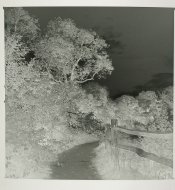The sky is blue because light scattering off molecules in the air has a very strong wavelength dependence favoring the blue (Rayleigh scattering off particles that are much smaller than the wavelength of light). However, light scattering off larger particles such as water droplets and haze is less blue. For the photographer, this means that humidity and haze will make the sky less blue and decrease the effect of the red filter (or yellow or orange). At high altitude, humidity and haze are less, and UV is stronger, but it isn't solely altitude.
In the UK on a clear day, you'll get less of a dark-sky effect than you would in the Southwest US on a clear day with 15% humidity. If you take the same scene with no filter, yellow filter, and red filter, you'll see that there is an effect, it's just much less pronounced when there is humidity or haze.
In the UK on a clear day, you'll get less of a dark-sky effect than you would in the Southwest US on a clear day with 15% humidity. If you take the same scene with no filter, yellow filter, and red filter, you'll see that there is an effect, it's just much less pronounced when there is humidity or haze.






